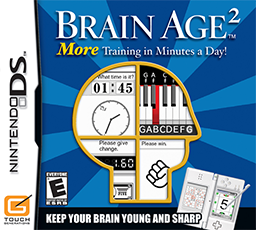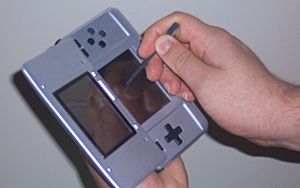Brain Age 2: More Training in Minutes a Day! facts for kids
Quick facts for kids Brain Age 2:More Training in Minutes a Day! |
|
|---|---|

North American box art
|
|
| Developer(s) | Nintendo SPD |
| Publisher(s) | Nintendo |
| Director(s) | Kouichi Kawamoto |
| Producer(s) | Shinya Takahashi |
| Composer(s) | Minako Hamano |
| Series | Brain Age |
| Platform(s) | Nintendo DS |
| Release date(s) |
|
| Genre(s) | Puzzle, edutainment |
| Mode(s) | Single-player, multiplayer |
Brain Age 2: More Training in Minutes a Day! is a fun puzzle game for the Nintendo DS. It's also known as More Brain Training from Dr Kawashima: How Old Is Your Brain? in some parts of the world. This game is a sequel to the popular Brain Age: Train Your Brain in Minutes a Day! from 2005. Nintendo developed and published it.
The main idea of the game is to help you keep your brain sharp. When you start, the game checks your "brain age." This age shows how quickly your brain responds. A brain age of 20 is the best score you can get. It means your brain is as quick as an average 20-year-old's. After this check, you can play many different mini-games. These games are designed to help improve your brain's speed and focus. You can then check your brain age again to see if you've improved!
Many people liked Brain Age 2. It got good reviews from game critics. They especially liked how it improved on the first Brain Age game. The game was very popular and sold millions of copies worldwide. It became one of the best-selling games for the Nintendo DS.
How to Play Brain Age 2
Brain Age 2 is an edutainment game. This means it's both fun and helps you learn or improve skills. It has many different minigames to play. First, you create your own profile in the game. Then, the game runs a "Brain Age Check." This check uses three random tests to figure out your brain age. Your brain age can be anywhere from 20 to 80. A lower age means your brain is more responsive.
After your first brain age check, you unlock three main ways to play:
- Quick Play: Here, you can practice any of the mini-games. You won't get a score, but it's great for getting better.
- Daily Training: This is where you can do your daily brain age check. You can also play one of the mini-games and get a score. The game also has a special puzzle game called Virus Buster. It's like a simpler version of Dr. Mario. The music in Virus Buster changes each day! The game saves your daily scores. This lets you see your progress on a graph.
- Sudoku: In this mode, you can solve one of 100 Sudoku puzzles.
All the mini-games in Brain Age 2 are new. They are different from the first Brain Age game. Some of the training activities include:
- Sign Finder
- Piano Player
- Word Blend
- Word Scramble
- Change Maker
- Calendar Count
- Memory Sprint
- Math Recall
- Clock Spin
- Block Count
You can collect stamps each day by completing mini-games. When you collect enough stamps, you unlock new mini-games and features!
Making of Brain Age 2
Nintendo first announced Brain Age 2 in Japan in October 2005. It was released there in December 2005. Later, it came out in Europe in June 2007 and in North America in August 2007. The game was made for people who play games casually, not just hardcore gamers. It kept the same basic ideas, graphics, and menus as the first Brain Age.
Brain Age 2 also uses the same Sudoku system as the first game. This system was very popular. The new game added 100 brand new Sudoku puzzles. Even though all the mini-games are new, some are based on ideas from the first Brain Age. For example, the first game had "Head Count." In Brain Age 2, there's a similar game called "Memory Sprint." In Memory Sprint, you watch a runner in a race and try to remember their final position.
The game also improved its voice recognition. This means it's better at understanding what you say into the microphone. One game, Rock, Paper, Scissors, uses this feature. You have to speak your answer quickly into the microphone.
Nintendo used famous people to help advertise Brain Age 2. Actress Nicole Kidman appeared in TV and newspaper ads in Europe. She said playing the game made her feel young. Swimmer Kieren Perkins promoted the game in Australia. In the United States, actress Liv Tyler was featured in ads for the game.
See also
 In Spanish: Más Brain Training del Dr. Kawashima ¿Cuántos años tiene tu cerebro? para niños
In Spanish: Más Brain Training del Dr. Kawashima ¿Cuántos años tiene tu cerebro? para niños
- Big Brain Academy
- Big Brain Academy: Wii Degree
- Brain Boost
- Brain Challenge
- Minna de Kitaeru Zenno Training
- Neurodegeneration
- Touch! Generations



